Ladies and Gentlemen...The Beatles!
A Beatles traveling exhibition presented by the Grammy Museum and Fab Four Exhibits, LLC
The Lyndon B. Johnson Presidential Library and Museum
Austin, Texas
June 13, 2015 - January 10, 2016
The special opening day event held on Saturday, June 13, 2015 was beyond spectacular with more than
4,000 Beatles fans attending. Throughout the entire day, the line to get inside stretched a quarter mile
and the typical wait time was 2 to 2-1/2 hours. Because of the enormous crowd, only 2,100 people
made it into the exhibit by the end of the day in order to give everyone ample room to move around
and ample time to take it all in. Outside, it was a party atmosphere as Beatles cover band The Eggmen
played for those standing in line as well as another 300 to 400 gathered in front of the stage.
As Grammy Museum Executive Director Bob Santelli said: "It feels like Woodstock!"
July 10, 2015 update:
We've heard from the folks at the LBJ Presidential Library that 17,365 fans visited the exhibit between
June 13th and June 30th, and they're still pulling in approximately 500 people daily. That's 17,635 people in just the first 17 days! On July 4, 2015, over 1,200 people went through the exhibit which, we were told, is a huge number on the 4th. We're thrilled that the exhibit is drawing such huge crowds at the LBJ Library which, by the way, is located on the campus of the University of Texas, alma mater of Fab Four Exhibits partner Mark Naboshek.
Mark attended the school from 1970-1974 and began his Beatles collection there.

VIP Cocktail Reception, Friday, June 12, 2015

LBJ Library members (Friends of the LBJ Library) took in the exhibit during
a special preview at the VIP reception on Friday, June 12, 2015, the night
before the public opening.

Meanwhile, upstairs in the Great Hall, Library members and special guests
munch on Texas-style delectables like barbecue sandwiches....

...share their memories of the Beatles...

...and partake from two open bars serving themed drinks like a strawberry concoction called, appropriately enough, "Strawberry Fields Forever".
Public Opening Day, Saturday, June 13, 2015
At 9am...

At 9:00am on opening day, the line to get inside the LBJ Library to see
the Beatles exhibit stretched from the main entrance...

...across the main plaza to the opposite wall...

...down the wall...
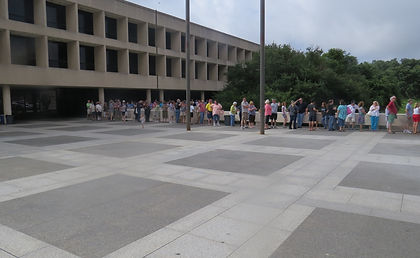
...and around the corner.

...and the line stayed the same length...all...day...long.
The wait in the blazing Texas sun was 2 to 2-1/2 hours.
By midday, with more crowds gathered outside to see The Eggmen play...
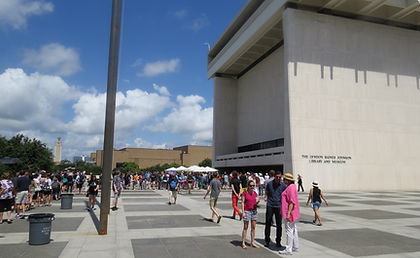
...the line still stretched...
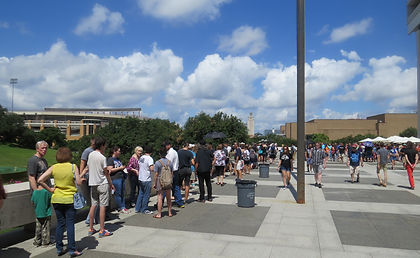
...down the wall...

...and around the corner...

...as far as the eye could see.

At 4pm, an hour before closing, fans at the end of the line were told they
wouldn't make it inside and were given vouchers to come and see the
exhibit free on another day. Those still in line were rerouted down the side
of the Library building and were the last to be let inside for the day.
By midday...

Outside on the plaza, while the crowds waited to get inside...
...one of Austin's top Beatles cover bands, The Eggmen, played two sessions - one from 10am until noon, and one from 1pm
until 3pm. Those who decided not to endure the long lines stayed around for the music, joined by those exiting the exhibit.
It was a true party atmosphere as people of all ages, from small children to their grandparents, sang and danced along!
















Still others took refuge from the heat in nearby covered areas, cooling off with refreshments from concession stands and food trucks.
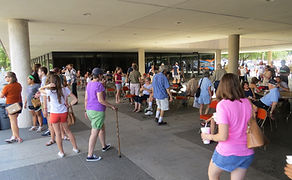

Once inside, the line continued, stretching
down a long hallway....


...to the exhibit entrance.


First up: A U.S. map with a sampling of unused
North American concert tickets from 1964-1966.
Meanwhile, inside the exhibit...

FFE partner Mark Naboshek posing with
the exhibit's introductory text board.

The crowd thought they had to stay in line when
they were actually free to roam the exhibit!

A little Beatles pre-history with a display about skiffle, the music genre that swept England in the late 1950s. The first incarnation of the Beatles was John's first band, a skiffle group called the Quarrymen.
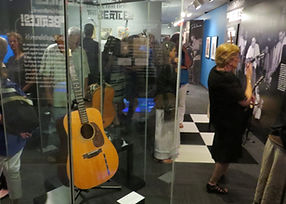
Displayed back-to-back with the Buddy Holly guitar
is Elvis Presley's 1942 Martin D-18 acoustic used in 1954-1955, most significantly on his Sun recordings.

The Beatles weren't an overnight success, popping up out of nowhere in February 1964. By that time, they'd been together for nearly seven years. Here, items from 1960-1962 are showcased.

The start of the second leg of the exhibit...

...where one of the most famous Beatles guitars
was on display.

At the far left, a display of photos by Beatles tour manager Bob Bonis and, on the right, fans taking
in the display of artifacts related to the group's
first American visit.

FFE partner Russ Lease (right) chats with a fan about his first visit artifacts, most notably the Sullivan drumhead.

Above and below: A display that celebrates the Beatles' two full-length films -- A Hard Day's Night (1964) and HELP! (1965) -- as well as their Saturday morning cartoon series.


Four historic Beatles documents. From left:
Paul McCartney's handwritten draft for "What You're Doing", a 1960 Stu Sutcliffe handwritten set list, the John Lennon-penned set list used at
their first American concert and a legal agreement signed by all four Beatles during
their first U.S. visit.

A look down the first leg of the exhibit.

The iconic Sullivan show stage display complete
with vintage instruments, 3D arrows and a
replica of the riser used for Ringo's drum kit.

A display of clothing, records and documents
related to the American acts that influenced
the Beatles.

Early Beatles American singles and two significant issues of Mersey Beat from 1962 covering news of the boys' audition with EMI and their first recording session.
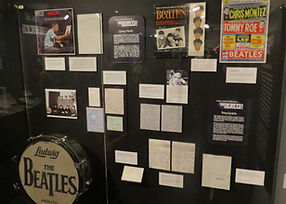
A display of items related to Beatles manager Brian Epstein and their producer George Martin. Also featured is the original "Drum City" drumhead used at Madame Tussauds in London in 1964.

In the news: John Lennon's long-missing,
headline-making Gibson J-160E guitar from 1962,
verified as recently as 2014. One of John's all-time
favorite guitars, it was used in 1962 and 1963, both live and in the studio. This was its first-ever public display, but only from June 13th through June 29th.
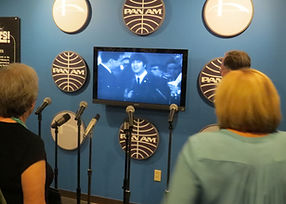
Fans watch a video of the Beatles' arrival in America at the replica of the Pan Am Lounge at JFK International Airport, site of the group's first
press conference.

Fans take a closer look at the Sullivan stage set-up.

The Beatles idolized Buddy Holly. This is Buddy's 1943 Gibson J-45 with a tooled leather cover that the Texas legend created himself.

The earliest known Beatles set list from June 1960
and another from April 1963 -- both handwritten
by Paul McCartney.

One of the favorites on the exhibit tour, the fan's bedroom shows what it was like to live with a
Beatles-obsessed teen in the 1960s.

FFE partner Mark Naboshek (right) with Matt and Leslie Healy of San Angelo, Texas. As a young teen, Leslie met and interviewed the Beatles during a trip to England.

Beyond Lennon's famous Gibson J-160E, the story
of the Beatles' breakthrough in America awaited
the steady stream of fans.


Visitors watch a documentary about the Beatles' live American television debut on The Ed Sullivan Show, February 9, 1964.
First visit artifacts, including the original drumhead used for all three Ed Sullivan Shows and the gold record award for the "I Want To Hold Your Hand" single presented to the group at New York's Plaza Hotel in February 1964.
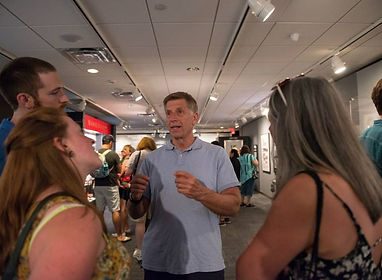

Grammy Museum Executive Director Bob Santelli (center) talks about the exhibit with Alex and Rachel Huth of Marion, Texas (left) and Becky Lease, wife of FFE partner Russ Lease...
...and poses with Fab Four Exhibits'
Mark Naboshek.

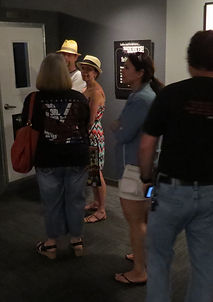
Window on the past. First-generation fans took a trip back in time to their formative years, gazing into the Woolworth's window at an impressive selection of original Beatles merchandise. Along with the toys, original promotional posters for many of those items were on display.
Visitors waiting in line at the audio
booth for the chance to record their memories of the Beatles for archiving
at L.A.'s Grammy Museum.

Rounding the corner to the third and final leg of the exhibit, a fan takes a photo of Paul McCartney's
original Shea Stadium jacket.

Some of the band's American LP and single record releases as well as 1964 North American tour ephemera like concert tickets and a set of autographs signed in Dallas in September 1964.

Looking to the end. The final leg of the exhibit.

The original Edwardian jacket Ringo Starr wore
on the cover of the Abbey Road album and,
beyond, a video room.

Taking drum lessons from Ringo Starr.

Artifacts from 1965 and 1966, including an original
Rubber Soul gold record award, the Butcher cover
story and tour-related material.
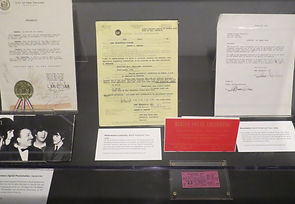
September 1964 proclamation declaring "Beatles Day
In New Orleans" (signed by the Beatles) plus
Hollywood Bowl '64 and tour documents.

A pair of John Lennon's granny glasses from 1967 and the set list from George's guitar used at their last concert at Candlestick Park in August 1966.

Photo op for fans. Steve and Trisha McNutt of Dallas
take a stroll across Abbey Road. Note the LBJ Library building on the horizon!
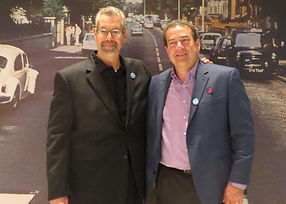
Thrilled with the turnout: Fab Four Exhibits
partners Mark Naboshek and Russ Lease.
LBJ Library Beatles exhibit lets visitors relive British Invasion
Article by Cat Cardenas, The Daily Texan, June 17, 2015
Symptoms of Beatlemania swept a record-breaking crowd on Saturday as they spent hours in a sweaty frenzy, waiting to enter the LBJ Presidential Library’s latest exhibit.
More than 50 years after The Beatles’ inception, the new exhibit — Ladies and Gentleman…The Beatles! — features over 400 pieces of Beatles memorabilia ranging from records to wardrobe and will remain open through January 2016.
Open for less than a week, the exhibit surpassed staff expectations, welcoming 2,100 people on its first day.
Visitors can walk across a mock-up of Abbey Road and admire John Lennon’s Gibson guitar, on display until June 29, which he used to write some of the band's early hits such as “I Want to Hold Your Hand.” The exhibit also features an oral history booth which Bob Santelli, Grammy Museum Executive Director, said allows fans to record their favorite memories of the band.
“I was directing people to the booth that were at their concerts, that grew up listening to them,” Santelli said. “They all felt like they had these personal connections that were still strong today. People felt like they knew them.”
Fab Four Exhibits, LLC, a group of four avid Beatles collectors, owns the majority of the artifacts. The group pooled pieces of their collections together and partnered with the Grammy Museum to create a traveling exhibit focused on The Beatles’ North American years. Russ Lease, a Beatles collector for 35 years, said the group wanted to share with other fans.
“Nothing like this has ever been done before,” Lease said. “For years these pieces have been in people’s houses, in their basements, and it was time that other people got the chance to see them.”
Lease and his partners are some of the foremost collectors of Beatles memorabilia in the country. He said The Beatles’ 1964 appearance on the Ed Sullivan show first sparked his interest in the band.
Years later, he became the proud owner of the drumhead they used in the historic television performance and is now part of the exhibit.
“I was just 7 years old during the Ed Sullivan performance,” Lease said. “I vividly remember seeing it. Getting that drumhead was getting a piece of American history. It was one of the most important entertainment moments of the millennium.”
With 73 million fans tuning in to watch, The Ed Sullivan performance is often cited as the beginning of the British Invasion. But before British artists invaded the U.S., American musicians, such as Little Richard and Buddy Holly, had already begun to influence Britain.
Santelli said many of the exhibit’s artifacts speak to America’s affect on The Beatles.
“Some of the coolest things in the exhibit are the setlists,” Santelli said. “People are always surprised by how many American songs they were playing. What The Beatles did was interpret that music and give it back to us.”
Santelli said watching different generations of fans come through the exhibit has proven the band’s lasting success, demonstrating their continued cultural impact decades after their break up.
“On opening day, grandparents and grandchildren were side by side,” Santelli said. “Those songs stuck with them and they want to share them. The Beatles made connections with the public through their music.”
LBJ museum curator Mike MacDonald, said the exhibit is a perfect fit for the library — despite the fact that President Johnson wasn’t particularly fond of the mop-topped group.
“We focus on the ʼ60s and The Beatles provided the soundtrack to the ʼ60s,” MacDonald said. “They changed American history from pop culture to way people thought. It was a fundamental change in American culture.”
UT Alum Honors The Beatles With Memorabilia Collection
Article by Tess Cagle, ORANGE Magazine, October 23, 2015
See the original article here:
http://www.orangemagazine.co/music/2015/10/22/ut-alum-honors-the-beatles-with-memorabilia-collection
More than fifty years after the Beatles made their debut in America, forever changing the landscape of music history, the country has a new Fab Four to boast about: four men who have dedicated their lives to preserving music history by collecting Beatles memorabilia. These collectors helped curate the Ladies and Gentlemen…The Beatles! exhibit currently on display at the LBJ Presidential Library on the University of Texas at Austin’s campus.
For UT alum and Fab Four collector Mark Naboshek, the exhibit’s time in the library is particularly special because he first began his own Beatles collection on the Forty Acres. A small portion of his items are featured in Ladies and Gentlemen…The Beatles!, which showcases more than 400 Beatles artifacts and demonstrates the band’s impact on American culture from the time they first visited the U.S. in 1964.
Naboshek is a true first-generation Beatles fan. He was 12-years-old when the band made their iconic U.S. debut on “The Ed Sullivan Show” on Feb. 9, 1964. He says that prior to the British invasion, American music was mediocre, and the industry was dominated by girl groups, folk singers, and novelty and comedy records. “It was kind of a throwover from the ‘50s. Then the Beatles came in, and the best comparison I can make is when you walk into a dark room and flip the light on,” Naboshek says. “It was like when Dorothy lands in the house in black and white and she opens up the door to Oz and there’s color. It was that kind of a shake-up in what we were listening to.”
Although Naboshek grew up with the Beatles, he admits his own Beatlemania didn’t begin until his freshman year at UT, where he studied in the College of Communication, in 1970 — the same year the band broke up. He recalls finding live bootlegs — unlicensed recordings of Beatles concerts — at a record store called the Inner Sanctum. “I bought them, and they were like $2 or $3 apiece,” Naboshek says. “I wasn’t consciously starting to collect. I was just buying Beatles records. At one point, I went, ‘You know what? I’ve got 100 albums. I guess I’m a collector.’”
In addition to buying bootlegs, Naboshek completed his collection of official albums at Discount Records, which was located a block north of the University Co-Op on Guadalupe Street in the ‘70s. But by the next decade, he had moved on from collecting just Beatles records. “I thought I didn’t need a hundred copies of ‘She Loves You,’ ” Naboshek says. “I stopped with the record collecting for the most part and started buying the memorabilia.”
Naboshek bought everything from Beatles puzzles and games, to Halloween costumes and toy guitars. His collection now numbers in the thousands, with most items dating back to the ‘60s when the band was still together. Although Naboshek declined to give the exact value of his collection, he emphasized that it is worth a “considerable” amount.
Naboshek discovered more than just his love for the Beatles while at UT — he also met his wife Bev. She says ever since she met her husband on a blind date in 1972, the Beatles have always played an important role in their relationship. “It's part of who we are,” she adds.
Bev says she’s always supported her husband’s hobby, like when she bought him a bootleg 40 years ago or when she attends the GRAMMY Museum events today. She is especially proud of this exhibit, calling it “the culmination of everything Mark had done in his hobby over all those decades of collecting.”
Fellow memorabilia collector and longtime friend Eric Cash says Naboshek was “born to be a Beatles collector.” He recalls the time Naboshek chanced upon a rare Beatles record worth $1,800 in a Half Price Books and Records store and says things like this happen to Naboshek all the time. “Collecting is a very strong, common bond between us,” Cash says. “You don't need it, so the passion to buy it must be strong, and a common, strong passion is a very strong bond between people.”
Naboshek says his most prized item is the original setlist, written by John Lennon, from the Beatles’ first concert in front of an American audience in Washington D.C. just days after their “Ed Sullivan Show” performance. He says the original owner of the setlist had been trying to collect jelly beans thrown at the band at the front of the stage when a police officer approached her and handed her the list. She kept it until 1994, when she sold it to Naboshek for $5,000. “I was the first collector who laid eyes on it, and I’m the first collector — and only — who’s ever owned it,” Naboshek says. The setlist can be viewed in the exhibit.
Along with the setlist, Naboshek says most of the artifacts he contributed to the exhibit come from the early ‘60s, before the Beatles were famous. These include tickets and handbills from the band’s performances in Liverpool. “A lot of people just think they popped up overnight on ‘The Ed Sullivan Show,’ when in fact they’d been together for over eight years by then,” Naboshek says. “So we want to show people that they had a struggle. They struggled like any band in Liverpool.”
Naboshek says that as a first-generation fan, it’s difficult to convey how groundbreaking the Beatles were in the ‘60s. “Obviously, it still resonates today because they’re designated as the top pop act of all time,” Naboshek says. “They’re probably the greatest band of the 20th century. I think they’ll be remembered for hundreds of years, just like Beethoven.”
If the numbers are any indication, Naboshek isn’t alone in his opinion. In the second half of June, 17,365 people visited Ladies and Gentlemen…The Beatles! — the largest number of visitors for any LBJ Library exhibit in its opening month. Throughout the summer, when attendance is typically sparse, the library still brought in approximately 500 people a day. Naboshek says the Beatles exhibit even edged out the GRAMMY Museum’s Sinatra: An American Icon exhibit in New York by 1 percent, becoming the museum’s largest opener ever. “It’s amazing to me that they haven’t even been a group for 45 years, and they’re still influencing generation after generation of people,” he says. “I don’t know of any other group that does that.”